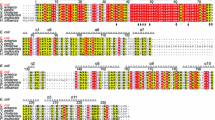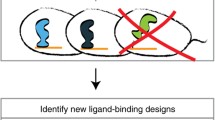Abstract
FadR is a versatile global regulator in Escherichia coli that controls fatty acid metabolism and thereby modulates the ability of this bacterium to grow using fatty acids or acetate as the sole carbon source. FadR regulates fatty acid metabolism in response to intra-cellular concentrations of acyl-CoA lipids. The ability of FadR to bind acyl-CoA fatty acids is thus of significant interest for the engineering of biosynthetic pathways for the production of lipid-based biofuels and commodity chemicals. Based on the available crystal structure of E. coli bound to myristoyl-CoA, we predicted amino acid positions within the effector binding pocket that would alter the ability of FadR to bind acyl-CoA fatty acids without affecting DNA binding. We utilized fluorescence polarization to characterize the in vitro binding properties of wild type and mutant FadR. We found that a Leu102Ala mutant enhanced binding of the effector, likely by increasing the size of the binding pocket for the acyl moiety of the molecule. Conversely, the elimination of the guanidine side chain (Arg213Ala and Arg213Met mutants) of the CoA moiety binding site severely diminished the ability of FadR to bind the acyl-CoA effector. These results demonstrate the ability to fine tune FadR binding capacity. The validation of an efficient method to fully characterize all the binding events involved in the specific activity (effector and DNA operator binding) of FadR has allowed us to increase our understanding of the role of specific amino acids in the binding and recognition of acyl-CoA fatty acids and will greatly facilitate efforts aimed at engineering tunable FadR regulators for synthetic biology.


Similar content being viewed by others
Abbreviations
- TR:
-
Transcriptional regulator
- LCACoAs:
-
Long chain acyl-coenzyme A thioesters
- WT:
-
Wild-type
- GST:
-
Glutathione S-Transferase
- SDS:
-
Sodium dodecyl sulfate
- EMSA:
-
Electrophoretic mobility shift assay
References
van Aalten DM, DiRusso CC, Knudsen J, Wierenga RK (2000) Crystal structure of FadR, a fatty acid-responsive transcription factor with a novel acyl coenzyme A-binding fold. EMBO J 19(19):5167–5177. doi:10.1093/emboj/19.19.5167
Raman N, Black PN, DiRusso CC (1997) Characterization of the fatty acid-responsive transcription factor FadR. Biochemical and genetic analyses of the native conformation and functional domains. J Biol Chem 272(49):30645–30650
Subrahmanyam S, Cronan JE Jr (1998) Overproduction of a functional fatty acid biosynthetic enzyme blocks fatty acid synthesis in Escherichia coli. J Bacteriol 180(17):4596–4602
DiRusso CC, Tsvetnitsky V, Hojrup P, Knudsen J (1998) Fatty acyl-CoA binding domain of the transcription factor FadR. Characterization by deletion, affinity labeling, and isothermal titration calorimetry. J Biol Chem 273(50):33652–33659
Cortay JC, Negre D, Galinier A, Duclos B, Perriere G, Cozzone AJ (1991) Regulation of the acetate operon in Escherichia coli: purification and functional characterization of the IclR repressor. EMBO J 10(3):675–679
Fujita Y, Matsuoka H, Hirooka K (2007) Regulation of fatty acid metabolism in bacteria. Mol Microbiol 66(4):829–839. doi:10.1111/j.1365-2958.2007.05947.x
Farewell A, Diez AA, DiRusso CC, Nystrom T (1996) Role of the Escherichia coli FadR regulator in stasis survival and growth phase-dependent expression of the uspA, fad, and fab genes. J Bacteriol 178(22):6443–6450
DiRusso CC, Heimert TL, Metzger AK (1992) Characterization of FadR, a global transcriptional regulator of fatty acid metabolism in Escherichia coli. Interaction with the fadB promoter is prevented by long chain fatty acyl coenzyme A. J Biol Chem 267(12):8685–8691
Gui L, Sunnarborg A, LaPorte DC (1996) Regulated expression of a repressor protein: FadR activates iclR. J Bacteriol 178(15):4704–4709
Cronan JE Jr (1997) In vivo evidence that acyl coenzyme A regulates DNA binding by the Escherichia coli FadR global transcription factor. J Bacteriol 179(5):1819–1823
Xu Y, Heath RJ, Li Z, Rock CO, White SW (2001) The FadR·DNA complex. Transcriptional control of fatty acid metabolism in Escherichia coli. J Biol Chem 276(20):17373–17379. doi:10.1074/jbc.M100195200
DiRusso CC, Black PN, Weimar JD (1999) Molecular inroads into the regulation and metabolism of fatty acids, lessons from bacteria. Prog Lipid Res 38(2):129–197
van Aalten DM, DiRusso CC, Knudsen J (2001) The structural basis of acyl coenzyme A-dependent regulation of the transcription factor FadR. EMBO J 20(8):2041–2050. doi:10.1093/emboj/20.8.2041
Feng Y, Cronan JE (2009) Escherichia coli unsaturated fatty acid synthesis: complex transcription of the fabA gene and in vivo identification of the essential reaction catalyzed by FabB. J Biol Chem 284(43):29526–29535. doi:10.1074/jbc.M109.023440M109.023440
Zhang F, Carothers JM, Keasling JD (2012) Design of a dynamic sensor-regulator system for production of chemicals and fuels derived from fatty acids. Nat Biotechnol 30(4):354–359. doi:10.1038/nbt.2149
Zhang F, Ouellet M, Batth TS, Adams PD, Petzold CJ, Mukhopadhyay A, Keasling JD (2012) Enhancing fatty acid production by the expression of the regulatory transcription factor FadR. Metab Eng 14(6):653–660. doi:10.1016/j.ymben.2012.08.009S1096-7176(12)00101-2
Peralta-Yahya PP, Zhang F, del Cardayre SB, Keasling JD (2012) Microbial engineering for the production of advanced biofuels. Nature 488(7411):320–328. doi:10.1038/nature11478nature11478
Schweizer HP, Klassen T, Hoang T (1996) Improved methods for gene analysis and expression in Pseudomonas spp. In: Molecular biology of pseudomonads. ASM Press, Washington, DC, pp 229–237
Une T, Brubaker RR (1984) In vivo comparison of avirulent Vwa- and Pgm- or Pstr phenotypes of yersiniae. Infect Immun 43(3):895–900
Une T, Brubaker RR (1984) Roles of V antigen in promoting virulence and immunity in yersiniae. J Immunol 133(4):2226–2230
Hall RS, Martí-Arbona R, Hennelly SP, Maity TS, Mu F, Dunbar JM, Unkefer CJ, Unkefer PJ (2013) In-vitro characterization of an L-kynurenine-responsive transcription regulator of the oxidative tryptophan degradation pathway in Burkholderia xenovorans. J Mol Biol Res 3(1):55–67
Marti-Arbona R, Mu F, Nowak-Lovato KL, Wren MS, Unkefer CJ, Unkefer PJ (2014) Automated genomic context analysis and experimental validation platform for discovery of prokaryote transcriptional regulator functions. BMC Genom 15:1142. doi:10.1186/1471-2164-15-1142
Fang X, Li JJ, Tan W (2000) Using molecular beacons to probe molecular interactions between lactate dehydrogenase and single-stranded DNA. Anal Chem 72(14):3280–3285
Fowler DM, Fields S (2014) Deep mutational scanning: a new style of protein science. Nat Methods 11(8):801–807. doi:10.1038/nmeth.3027
Lee ME, Aswani A, Han AS, Tomlin CJ, Dueber JE (2013) Expression-level optimization of a multi-enzyme pathway in the absence of a high-throughput assay. Nucleic Acids Res 41(22):10668–10678. doi:10.1093/nar/gkt809
Fowler DM, Stephany JJ, Fields S (2014) Measuring the activity of protein variants on a large scale using deep mutational scanning. Nat Protoc 9(9):2267–2284. doi:10.1038/nprot.2014.153
Adamson J, Thorne D, Errington G, Fields W, Li X, Payne R, Krebs T, Dalrymple A, Fowler K, Dillon D, Xie F, Meredith C (2014) An inter-machine comparison of tobacco smoke particle deposition in vitro from six independent smoke exposure systems. Toxicol In Vitro 28(7):1320–1328. doi:10.1016/j.tiv.2014.06.012
Hatanaka M, White EA, Horibata K, Crawford IP (1962) A study of the catalytic properties of Escherichia coli tryptophan synthetase, a two-component enzyme. Arch Biochem Biophys 97:596–606
Author information
Authors and Affiliations
Corresponding author
Rights and permissions
About this article
Cite this article
Bacik, JP., Yeager, C.M., Twary, S.N. et al. Modulation of FadR Binding Capacity for Acyl-CoA Fatty Acids Through Structure-Guided Mutagenesis. Protein J 34, 359–366 (2015). https://doi.org/10.1007/s10930-015-9630-1
Published:
Issue Date:
DOI: https://doi.org/10.1007/s10930-015-9630-1




